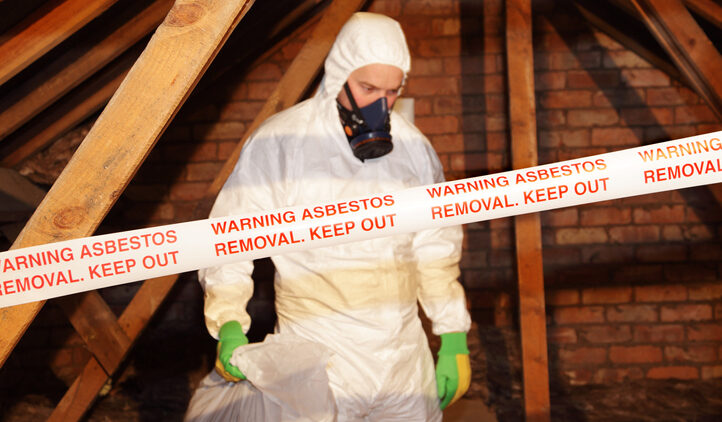Prior to the early 1980s, dozens of military and civilian jobs put workers at risk of exposure to asbestos. Asbestos exposure is now known to cause mesothelioma and other deadly illnesses. Get help if you faced asbestos exposure at work and are now fighting mesothelioma.
Why Did Occupations Use Asbestos?

Before the dangers of asbestos were well-known, it was used every day by millions of workers across the country.
Asbestos was used in many industries because of its strength, durability, and resistance to heat. It could be found in construction materials, insulation, and many products exposed to high temperatures or friction.
However, asbestos is now known to be a life-threatening substance that's put these workers at risk.
Any level of exposure can cause asbestos-related diseases, like:
Those who worked in the U.S. military were at a particularly high risk of asbestos exposure. In fact, veterans make up 33% of all mesothelioma cases.
High-Risk Asbestos Exposure Occupations
Occupations with high risk of asbestos exposure included:
- Aircraft mechanics: Asbestos was used in brake pads, adhesives, engines, and electrical insulation components in aircraft. Mechanics were exposed to asbestos when repairing these types of vessels.
- Aeronautical engineers: Aeronautical engineers were at a greater risk of asbestos contamination if they worked around planes that were being retrofitted. Further, when planes were being maintained, aeronautical engineers could be exposed to asbestos used to insulate the aircraft.
- Auto mechanics: Vehicles used asbestos in many components, such as brake linings and clutches. Mechanics who worked on replacing brake pads or repairing cars and other vehicles may have been exposed to asbestos as part of that process.
- Boilermakers: Asbestos was used as insulation for boilers, hot water heaters, and similar products. Boilermakers may have come into contact with the substance and unknowingly inhaled or ingested asbestos fibers.
- Brick and stone masons: Cement containing asbestos was commonly used in masons' mortar, thus increasing the likelihood that masons would develop an asbestos-related disease.
- Bulldozer operators: Bulldozer operators are instrumental in taking down older structures built with asbestos. As part of the demolition process, asbestos fibers could fly into the air, and bulldozer operators could breathe them in.
- Cabinet makers: The paper liners in cabinets were often made from asbestos. While this practice was discontinued in the 1980s, cabinet makers responsible for demolishing old cabinets and putting in new ones still have an increased risk of asbestos exposure.
- Carpenters: Carpenters were exposed to asbestos in many ways. Joint compound, insulation, plaster, and tiling containing asbestos were just a few of the products that put carpenters at risk.
- Chemical technicians: Chemical technicians often work with substances that contain asbestos. For example, asbestos is used as part of the process to make chlorine even today, according to a 2022 report from the news organization Reuters.
- Civil engineers: Civil engineers help with designing and building various structures. Prior to the 1980s, most buildings relied on asbestos. Many military engineers were also put at risk of exposure for similar reasons. For example, most U.S. Army bases were built with asbestos.
- Construction workers: Those who worked in the construction industry were at risk of breathing in asbestos fibers from building materials like piping, cement, wallboard, and tiling. Some modern construction materials may still contain asbestos.
- Crane operators: Crane operators demolish larger buildings and structures. Without proper precautions, this work could put them in danger if the structures in question were made with asbestos.
- Draftsmen: Draftsmen are involved in designing and building large structures like offices. While doing their job, they may come into contact with asbestos-based parts used to build the structures they designed.
- Drill press operators: Drill press operators generally work with metal objects. Unfortunately, many metal substances used in metalworking contain asbestos. While drilling holes, the drill press operators could have breathed in asbestos dust.
- Drywall tapers: Drywall was often made with asbestos because it is lightweight. Tapers were exposed to the raw edges of drywall and routinely breathed in asbestos as part of their job.
- Shipyard workers: These workers had to install, repair, and remove asbestos that was used throughout vessels. Those who served in shipyards operated by the U.S. Navy were at very high risk. Government regulations meant that virtually every U.S. Navy ship was built with asbestos.
Other Occupations at Risk for Asbestos Exposure
Many other occupations, including both military and civilian jobs, have been associated with asbestos exposure.
These jobs include:
- Deckhands and sailors
- Electricians
- Electrical engineers
- Electric power linemen
- Factory workers
- Firefighters
- Forgemen
- Freight and smelter operators
- Garage mechanics
- Grinding machine operators
- Heavy equipment operators
- Home inspectors
- Household appliance installers
- HVAC workers
- Insulators
- Industrial plant workers
- Industrial engineers
- Ironworkers
- Machinists
- Merchant marines
- Mechanical engineers
- Metal lathers
- Millwrights
- Miners
- Mixing operators
- Molders
- Oil refinery workers
- Operating engineers
- Painters
- Pipefitters
- Plasterers
- Plumbers
- Police officers
- Power plant workers
- Railroad workers
- Road machine operators
- Sales engineers
- Sawyers
- Stationary engineers
- Sheet metal workers
- Steamfitters
- Structural metal craftsmen
- Telephone repairmen
- Textile operators
- Tinsmiths
- Toolmakers
- Welders
- Weavers
Asbestos exposure prior to the 1980s was common in many of these fields, and anyone who worked at these jobs is at risk of mesothelioma today.
If you worked in any of the above occupations or were in the military and have been diagnosed with an asbestos-related disease, we can help.
High-Risk Asbestos Jobs and Secondhand Exposure
Even if you didn't work directly with asbestos, you may have come into contact with this toxic mineral if you lived with someone who worked around asbestos.
This is known as secondhand exposure, and it occurs when a worker unknowingly carries asbestos fibers home on their clothing or in their hair.
For example, a woman in her mid-30s was diagnosed with mesothelioma after being exposed to asbestos as a child. Her father worked as an electrician and would come home covered in asbestos dust. His clothes would hang in the washroom, which was also his daughter's playroom.
Occupational Asbestos Exposure and Mesothelioma Risks
If you worked in a profession with a high risk of asbestos exposure, you are at risk of mesothelioma today.


Asbestos-related diseases can take 10-50 years to appear, and they can mimic less severe illnesses.
Check with a doctor if you experience symptoms such as coughing or shortness of breath. These could be signs of mesothelioma or another asbestos-related illness.
Getting a proper mesothelioma diagnosis early on can help extend your life expectancy and ease your symptoms.
Help After Occupational Asbestos Exposure
Many industries stopped using asbestos in the 1980s, but that doesn't change the fact that millions of workers were already put at risk of mesothelioma – including many brave U.S. veterans.
If you or a loved one was diagnosed with an asbestos-related disease, the Mesothelioma Veterans Center is here to help.
Our caring veterans support team can connect you with VA benefits, compensation, and medical care.
Get started right now by requesting our Free Veterans Packet.
FAQs About Asbestos Exposure Occupations
What workers are involved in high risk asbestos exposure jobs?
Dozens of jobs put workers at risk of asbestos exposure, including military service, construction work, and boilermaking.
Anyone who served in these jobs prior to the early 1980s could go on to develop mesothelioma or another asbestos-related illness later in life.
What should I do if I worked with asbestos?
If you worked with or around asbestos, monitor yourself for symptoms of serious illnesses like mesothelioma and talk with your doctor about your history of exposure.
You can also contact us now to learn about medical, military, and financial resources that may be available to you.
Do all asbestos workers get mesothelioma?
No. Some people who worked with or around asbestos may develop lung cancer. Others may develop asbestosis, which is a noncancerous but possibly deadly lung disease.
Finally, some workers may never get sick.
What is the most common exposure to asbestos?
Asbestos exposure most commonly happens at work. Employees may unknowingly breathe in or swallow microscopic asbestos fibers that have been released into the air.

